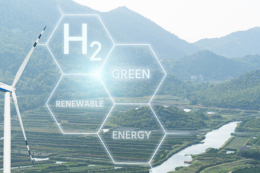By Pati Pietek
U.S. Patent No. 11773542, Piezoelectric-based Asphalt Layer for Energy Harvesting Roadway
As concerns over climate change escalate, the demand for alternative energy solutions intensifies. With the global population expanding alongside the rise in motor vehicle usage, there’s a pressing need for energy harvesting innovations in road pavements to harness the energy expended by vehicle loads and solar exposure on road surfaces. The quest for sustainable infrastructure in civil engineering has led to exploring various methods to minimize the environmental impact of road transport. Among these methods, energy harvesting (EH) has emerged as a promising approach to harness the wasted thermal and kinetic energy from road and highway environments, thereby enabling renewable energy generation. EH systems embedded in pavements typically utilize piezoelectric transducers, electromagnetic generators, thermoelectric generators, photovoltaic panels, and solar collectors to capture energy.
Early models focused on utilizing thermal energy from paved areas through fluid-filled or air-filled ducts embedded in pavements. These systems capitalize on thermal energy from solar radiation and water to regulate surface temperature, facilitate snow melting, and even provide air conditioning for nearby buildings. Additionally, thermoelectric cells exploit the temperature differential between pavement surfaces and base layers to generate electricity.
Experimental applications of photovoltaic systems on roads have shown potential, although challenges such as excessive noise, rapid degradation, and suboptimal electricity generation have been reported. Moreover, kinetic energy from vehicles can be harnessed using electromagnetic generators or piezoelectric transducers. Electromagnetic generators utilize electromagnetic induction from traffic displacement, while piezoelectric materials generate electricity when subjected to stress.
Piezoelectric energy harvesters (PEHs) offer versatility in installation methods, including direct compressive strain, cymbal forms, cantilevers, and vibration-based systems. Researchers at the University of South Florida have devised and patented a novel approach to produce, retain, and convey electricity using traffic loads which helps solve the issues in prior advancements.
In short, U.S. Pat. No. 11773542 discloses an energy harvesting roadway crafted with piezoelectric-based asphalt layers and blending piezoelectric materials with conventional asphalt for energy production. Vehicles traversing these roadways deform the piezoelectric-based asphalt layers, generating electricity through the piezoelectric effect, which is then stored for later use. The roadway design consists of conductive asphalt layers housing embedded transmission lines, with piezoelectric-based asphalt layers nestled between them. Outlet joints extend from the conductive layers, connected to full-wave rectifiers for power aggregation into energy storage devices. The road segments are interspersed with non-conductive asphalt layers to avoid charge interference between adjacent vehicles. The length of these segments can vary based on factors like vehicle size and speed. The invention encompasses different piezoelectric element designs, including cylindrical, spherical, and concave shapes, tailored for specific voltage generation needs. Cross-sections of road segments depict the layering structure, including optional non-conductive surface and base asphalt layers to enhance durability and weather resistance. Manufacturing the piezoelectric-based asphalt layer involves mixing piezoelectric elements with insulating fillers, such as regular asphalt, to prevent short-circuits. Waterproof layers may also be integrated to shield against moisture penetration.
Research indicates the importance of developing energy harvesters capable of withstanding the rigors of pavement life cycles to avoid premature failure. Cantilever and vibration-based systems, commonly used in various applications beyond roadways, offer potential solutions to mitigate PZT fatigue and enhance the reliability of EH systems for long-term use in transportation infrastructure. Being a newly emerging field, further exploration and refinement of these technologies are crucial to realizing their full potential in sustainable roadways.
Developing a business strategy in a newly emerging technological field can be challenging, especially if there are only a handful of patents that have been filed. DorothyAI’s Activ8 Alignment reports provides businesses and inventors with a 360-degree analysis on patents, trademarks, SEC filings, licensing, agreements, assignments, litigation, financial, market data by product category, and even a comprehensive view of the supply chain. In addition to the financial and market data used, Activ8 Alignment uses a proprietary “Jurisdictional Realities Database” that identifies 30+ factors for each jurisdiction, scoring these factors in five categories: innovation ecosystems, government policies, judicial systems, patenting processes, and commercial opportunities. This allows for crucial insights into novel technologies creating confidence in moving forward with scientific and business ventures.

